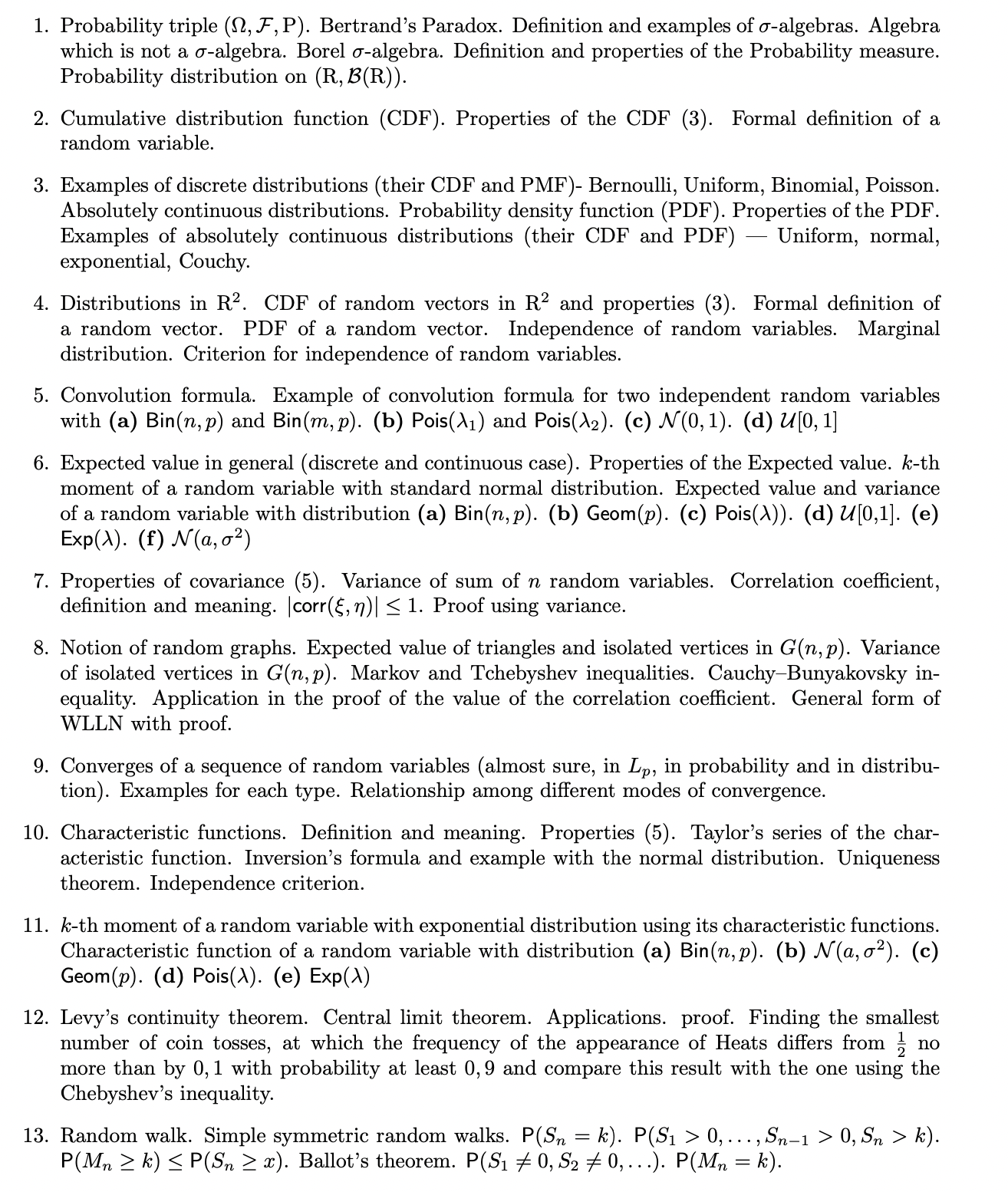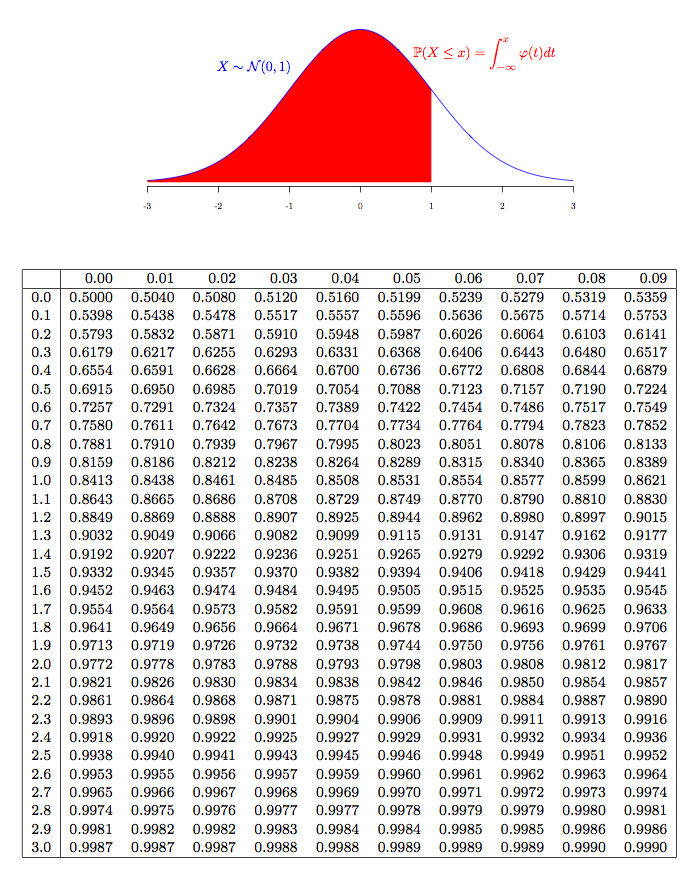Probability Theory (Spring 2022) -MSc Medical Biotechnology
Overview
This is the second part of the course. This semester, we will generalize the concept of a random variable as a measurable function. We will extensively use the CDF and the PDF of random variables to compute all their interesting numerical characteristics. As a whole, we will completely construct the concept of a propability space. We will conclude our course with the proof of one of the main results in probability theory - the central limit theorem.
Problem sets
Problem set 1. Discrete probability.
Problem set 2. Discrete joint probability distribution.
Problem set 3. Cumulative distribution function (CDF) and density (PDF)
Problem set 4. Random vectors. Convolution formula.
Problem set 5. Expected value. Variance. Covariance.
Problem set 6. Characteristic functions.
Problem set 7. Central limit theorem.
Problem set 8. Simple random walk.
Attendance & Marks
Attendance list.
Marks.
Topics discussed in lectures
Lecture 1 (24.02) General review of the material of the first semester.
Seminar: Problems 1,2,3 (problem set 1)
Lecture 2 (03.03) Random vector. Joint discrete PMF and its properties. Marginal PMF. Continuity property of the probability measure. Borel sigma-algebra. Probability distribution on (R, B(R)). Сumulative distribution funcion (CDF).
Seminar: Problems 6,7 (problem set 1) and 1,2,3 (problem set 2)
Lecture 3 (10.03) Formal definition of a random variable. Properties of the CDF. Examples of discrite distributions - Bernoulli, uniform, Binomial, Poisson. Asolutely continuous distributions.
Seminar: Problems 4,5,6 (Problem set 2) and 1,8 (problem set 3)
Lecture 4 (17.03) Probability density function (PDF). Properties of the PDF. Examples of absolutely continuous distributions - Uniform, normal, exponential. Ditributions in R^2. CDF of random vectors in R^2 and properties (3).
Seminar: Problems 2,3,5,7,9 (Problem set 3)
Lecture 5 (17.03) Discrete distributions in R^2. Absolutely continuous distributions of random vector. Random vector as a composition of random variables. Independence of random variables. Marginal distribution. Criterion for independency of random variables. Convolution formula.
Seminar: Problems 10,11,12 (Problem set 3)
Lecture 6 (31.03) Example of convolution formula for two independent standart normal random variables. Expected value in general (discrete and continuous case). Finding the expected value and the variance of a normal random variable.
Seminar: 1,2,3,4 (problem set 4)
Lecture 7 (07.04) Covariance. Linearity and symmetry. Variance of sum of n random variables. Markov and Tchebyshev inequalities. Couchy inequality. Proof that |cov(X,Y)|<=1.
Seminar: 5,6,7,8,9 (problem set 4)
Lecture 8 (21.04) Random graphs. Number of triangles in a random graph. Types of convergence of random variables. Examples of every type of convergence.
Seminar: 1,2,3,4,5,6,7(problem set 5)
Lecture 9 (28.04) Relationship among different modes of convergence. Characteristic functions. Some examples (Ber(p), N(a,sigma^2)).Properties (5). Taylor's series of the characteristic function.
Seminar: 8,9 (problem set 5), 1 (problem set 6)
Lecture 10 (05.05) Inversion's formula. Example with the normal distribution. Uniqueness theorem. Independence critereon. Levy's continuity theorem.Central limit theorem. Applications. proof of CLT.
Lecture 11 (12.05) Simple symmetric random walks. P(Sn=k). P(S1>0,...,Sn-1>0,Sn=k). P(Mn>=x)<=P(Sn>=x).
(31.05) --- CONSULTATION FOR TEST (ONLINE).
(7.06) --- CONSULTATION FOR EXAM (OFFLINE).
Exam Questions

Course guidelines and grading system
At the end of this course, you will get a grade from 1 to 10 (you need at least 3 to pass) according to the following parameters: (by the way, you can convert this grade into the 1-5 scale in the following way: 1-2 (Fail or 2/5), 3-4(Pass or 3/5), 5-7 (Good or 4/5), 8-10(Excellent or 5/5) )
- 1 point for class attendence (if you missed no more than 2 times)
- Max of 3 points for Test 1 [14.04]
- Max of 3 points for Test 2 [02.06]
- Max of 3 points for final exam on theory [09.06]
The number of points you get for each activity, is either an integer x or x+0.5.
If your final grade (after the final exam) is not an integer (z+0,5), you can solve an extra simple problem to raise your grade to z+1. Otherwise you get just z.
During the seminars, we will solve the problem sets. Each of you have to solve (or at least try to solve) these problems. I will randomly choose one of you so that you can explain to everyone your solution.
Since our group is composed of more than 30 students, I will check attendance in the following way: I will give at the begining of the class the attendance sheet and you must put an X next to your name. I will randomly verify at the end of the class who is there. If you have an X next to your name but you did not attendant class, you automatically lose the point for attendance.
References
- Probability (Graduate Texts in Mathematics) 2nd Edition by Albert N. Shiryaev.
- Introduction To Probability, Joseph K. Blitzstein, Jessica Hwang.
- Elementary probability 2nd Edition By David Stirzaker.
- Rick Durrett,≪Probability, Theory and Examples≫
- David Williams,≪Weighing the Odds≫
- Kai Lai Chung,≪A course in probability theory≫
- ≪Probability and Computing:Randomization and Probabilistic Techniques in Algorithms and
Data Analysis≫(2nd Edition). - Grimmett, Stirzaker≪Probability and random processes≫
- One Thousand Exercises in Probability
- Курс теории вероятностей и математической статистики, Севастьянов Б.A.
- Курс теории вероятностей, Чистяков В.П.
- Мера и интеграл, Дьяченко М.И.
Recommended Material

